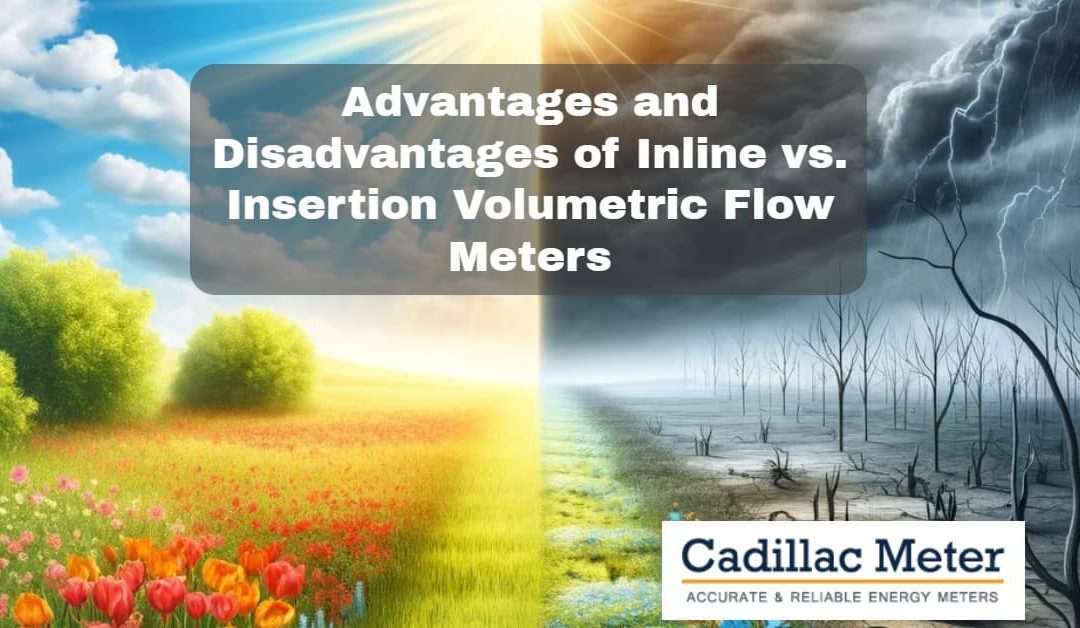When selecting certain types of volumetric flow meters you may be faced with the option of choosing either an in line flow meter or insertion style meter of the same technology. We will review some of the advantages and disadvantages of each option and how they may affect the flow measurement as well as cost to install for a typical application.
1. In line Flow Meters
- Advantage – Measure the entire cross sectional area of the flow profile providing more accurate representation of fluid velocity profile.
- Advantage – In line flow meters have control over the section of piping where the flow measurement is being made allowing for more precise cross sectional area calculation and thus more accurate flow measurement.
- Advantage – Depending on the type of volumetric technology selected the installation location of where the in line flow meter is to be mounted requires minimum lengths of piping straight run. Typical volumetric flow technologies require 10 pipe diameters upstream and 5 diameters downstream of piping straight run in order to create a fully developed flow profile. This will vary depending on the technology, but if Magnetic flow technology is selected this requirement may be significantly reduced to a little as 1 pipe diameter up and downstream of the meter flanges, which allows significant flexibility in selection of the location where the meter may be mounted.
Note: Typical volumetric flow technologies require 10 pipe diameters upstream and 5 diameters downstream of piping straight run in order to create a fully developed flow profile.
- Disadvantage – Flow meter cost – In larger line sizes 6.0″ and above the meter cost will typically be higher than insertion style meters.
- Disadvantage – Installation cost – Have to cut onto the flow line in order to install the Flow tube into the flow line, which requires much more time and material.
- Disadvantage – Removal from process. Typically to remove an inline meter, the process must be shut down and the section of line where the meter is installed must be drained or isolated with valves to remove the meter.
Note: To avoid some of the issues of flow meter removal from a process line a bypass may be installed during installation that allows the flow to be diverted and isolates the flow meter for removal. This does add additional cost, but allows removal without process disruption.
2. Insertion Volumetric Flow Meters
- Advantage – Flow meter cost – In larger line sizes 6.0″ and above the meter cost will typically be lower than inline style meters.
- Advantage – Installation cost – Limited installation cost with just a weld-o-let being required in some cases. Worst case is a 90 degree (to piping) flange connection.
- Advantage – Removal from process. Typically to remove an insertion meter the process may be kept in operation through the use of a Hot Tap assembly, which allows the insertion section to be removed and installed under pressure.
Note: The Hot Tap assembly does add 10%-20% cost to the insertion flow meter overall price, and the location of where the meter is to be installed must allow enough removal clearance for the hot tap assembly and the insertion flow element to be removed from the process. Depending on line size this may require at least 2-3 feet of removal clearance.
- Disadvantage – Measures a very small amount of the flow profile cross sectional area providing only a small representation of fluid velocity profile making it potentially much less accurate, velocity dependent, and insertion length critical.
- Disadvantage – Have no control over the section of piping where the flow measurement is being made creating a best guess using standard piping chart data for calculating the cross sectional area calculation and thus less accurate flow measurement.
- Disadvantage – location of where the meter is to be mounted must have a minimum of 10 pipe diameters upstream and 5 downstream of piping straight run to develop a complete and stable flow profile. This is critical due to the very small measurement cross-sectional area and may require 15 or greater pipe diameters upstream depending on turbulent generating conditions in the upstream piping.
- Disadvantage – Installation location of where the meter is to be mounted requires very long lengths of piping straight run, which may or may not be available especially in a retrofit situation. In addition, since insertion meters are more economical in larger lines sizes the overall length required to achieve the piping straight run becomes extreme. For example: a 16″ line would require a minimum of 27 feet of piping straight run in order to meet flow profile requirement.
Note: To avoid the extended straight run requirements for an insertion flow meter a flow straightener may be installed. However, this requires cutting into the line and installing the straightened flow section as with an inline meter and does add significant cost to the installation.



